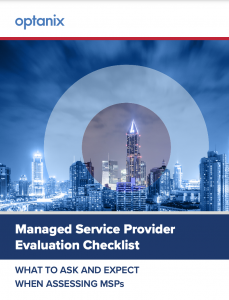
Managed Service Provider Metrics You Should Be Monitoring
How do you evaluate a managed service provider (MSP)? One of the best ways is through the use of key performance indicators or KPIs. Managed service provider metrics (or KPIs) may originate from data stored in the provider’s monitoring platform or from other sources. Either way, an MSP should be willing and able to produce metrics that speak to the effectiveness of their service.
Who Should Monitor Managed Service Provider Metrics?
There are three main audiences that find value in monitoring a managed service provider metrics:
- Prospective partners and customers of a managed service provider should use MSP metrics to help make informed decisions during the vendor selection process.
- Existing partners and customers of an MSP should monitor metrics to determine if the MSP is maintaining suitable levels of performance
- Those in management roles at an MSP organization should also monitor metrics to ensure a consistent level of service for their partners and customers, or better yet, that they are improving on their key performance indicators (KPIs)
 Need insight on evaluating a managed service provider for your organization? Download this MSP Evaluation Checklist to ensure you select the best partner.
Need insight on evaluating a managed service provider for your organization? Download this MSP Evaluation Checklist to ensure you select the best partner.
Managed Services Metrics to be Aware Of
The following list outlines some of the most important managed service provider metrics for an MSP’s partners, customers, and management to monitor:
High-Level MSP KPIs
The first batch of managed services KPIs that stakeholders should keep an eye on are general, high-level metrics that serve as indicators of the overall performance of an MSP and its offerings.
Customer Satisfaction Score (CSAT)
A customer satisfaction (CSAT) score is a strong indicator of the quality of the service delivered by an MSP. Net Promoter Score (NPS) is among the most prevalent CSAT metrics for managed services. Some MSPs prefer to go beyond the simple NPS approach – in which customers are asked just one question – and instead use detailed questionnaires or surveys to gain a more in-depth understanding of the customer experience.
Most MSPs will simply report an aggregate CSAT or NPS score that reflects the sentiments of all of their customers. However, it can be beneficial to ask them to provide scores that are specific to customers that fit certain criteria. For example, a prospective customer could ask to see an NPS score for all of the MSP’s existing customers that are in a certain vertical or that have a specific technology under management with the MSP.
Renewal Rate
Perhaps the most telling MSP performance metric is the renewal rate. This figure indicates that customers are receiving the service they expect from the MSP and that they are satisfied with that service. If a high percentage of customers choose not to renew with an MSP, then that MSP may have failed to set proper expectations for those customers or could simply be delivering subpar service.
An MSP should be able to explain any downturns in their renewal rate, and those downturns may not always be caused by an outright problem with the MSP’s service. In fact, customers often churn for reasons that are far outside the MSP’s control. For example, customers may choose not to renew because they want to bring all support in-house, because they are decommissioning or replacing the technologies that are supported by the MSP, or due to changing business conditions that have caused them financial hardships.
Return on Investment (ROI)
It is imperative for companies to calculate a projected return on investment (ROI) for all of their major expenditures. In the case of managed services, companies often look to MSPs to enable them to both decrease their costs (e.g., by eliminating the need for them to run an internal NOC) and increase their revenue (e.g., by improving the availability of revenue-generating channels such as catalog call centers). For these reasons, ROI is among the key metrics for managed services customers to scrutinize.
Any MSP should be willing and able to provide proof that they can produce a positive ROI. Preferably, such proof can be provided via an asset – such as a customer case study, white paper or ROI calculator – that has been prepared by an impartial third party.
Service Improvement Metrics
Companies often turn to MSPs in an effort to achieve a level of support they could not reach on their own. Such support may be needed to realize marginal yet impactful improvements in uptime for mission-critical business services – such as customer support contact centers – or to address major operational issues with such services. Either way, customers and MSPs should work together to establish service improvement metrics that can be used to gauge the success of a managed services engagement. For example, the customer and MSP could track the availability of the business services under management to determine if it improves during the course of the engagement.
Advanced Managed Services Performance Metrics
The second batch of MSP performance metrics to monitor are more granular metrics that focus on an MSP’s ability to execute.
Mean Time to Notify (MTTN)
Most companies prefer to be in the know when something is awry within their network. Mean time to notify (MTTN) represents the average amount of time that passes before a service outage or incident is reported to the customer by an MSP. MTTN is one metric that is best when lower rather than higher.
Most MSPs should provide an option for customers to set an MTTN objective that aligns with their business needs. The MSP’s historical MTTN data should indicate whether they can achieve that objective.
Mean Time to Repair (MTTR)
Mean time to repair (MTTR) represents the average time it takes for an MSP to repair (or “resolve”) an incident. It is perhaps the most commonplace of all the IT support metrics. Like its counterpart MTTN, MTTR is another metric that is best when lower.
Extended technical outages can cause serious loss of revenue for companies and affect their service delivery capabilities. MSPs that are able to quickly resolve high-priority incidents are key to the well-being of their customers’ operations.
Proactive Incident Resolution Percentage
While MTTN and MTTR are both important managed services performance metrics, they focus on the reactive side of managed services. The best MSPs are able to resolve a high percentage of customer issues proactively – that is before the customer notices the issue even took place. Such a proactive approach is usually achieved by arming engineers with a service assurance platform that delivers deep insight as well as dynamic monitoring and automation capabilities. These types of solutions enable MSPs to discover issues before they grow and fester into production-impacting problems
Ticket Volume
Another important IT support metric to monitor is ticket volume. This metric will vary greatly depending on a customer’s environment, managed device list and scope of coverage. The number of tickets generated by an MSP’s monitoring software should be reviewed on a recurring basis with focus paid to any trending devices or problems. Ideally, an MSP should be able to identify problems contributing to high ticket counts, isolate fixes and provide recommendations to resolve these issues. These recommendations and resolutions should generally lead to a decrease in ticket volume and a more stable environment.
Staffing Level
Though not a performance metric per se, it is advisable to keep a close eye on an MSP’s staffing levels. Managed service delivery can be resource-intensive, thus it is important to verify that an MSP’s engineering, customer support, and management teams are all staffed at levels capable of handling the total scope of its upcoming projects or deployments.
Leveraging Managed Service Provider Metrics
The managed service provider metrics described in this post leverage quantitative data to help highlight potential deciding factors between IT service providers. You can use them as a way to grade an MSP and track its performance. For the most effective approach to evaluating MSPs, combine these quantitative IT metrics with qualitative information to form a holistic view.
If you are seeking a Cisco MSP, click here to discover proven managed services from Optanix.